#universalproductcode
Explore tagged Tumblr posts
Text
What is a Universal Product Code (UPC)? - Types, Decoding
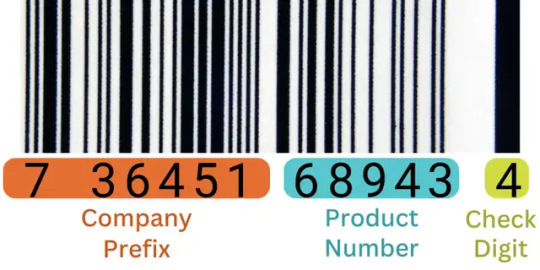
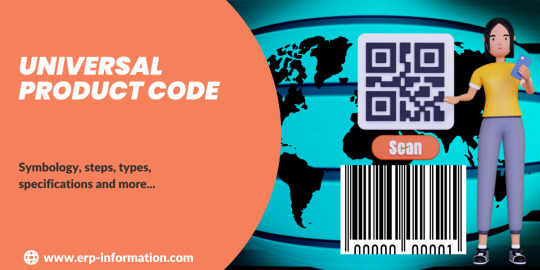
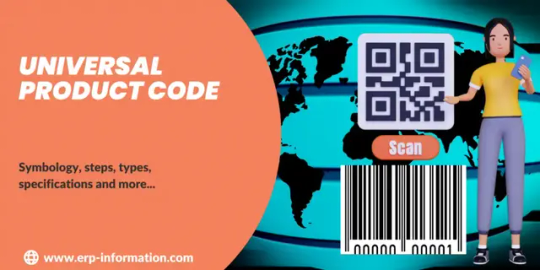
You've probably seen those barcodes with all the lines and squares on them, but what are they, and what do they do? They are Universal Product Codes. They track products through the supply chain. They're scanned at each point of sale to ensure that the correct product is being sold. It is a barcode symbology widely used in the United States and other countries. It consists of 12 digits that uniquely identify a product. You can find this code on most products that you buy in stores. This blog post discusses the definition, symbology, types, advantages, disadvantages, and requirements of UPC. In addition, the post explains the steps to get UPC for your product.
Definition
A Universal Product Code is a unique code assigned to every item sold in the store. The code helps identify the product, store traffic trends, and inventory details. That helps further in maintaining complete ordering information for the business. It provides real-time data to the store or the supermarket to ensure they never run out of stock for fast-moving items. It also makes the billing system easy and swift. UPC-E (includes zero) and UPC-A (does not have zero) are the two main types of Universal Product Codes.
UPC Symbology

It is made up of four parts: - The number system identifies the type of product; - The manufacturer code, which UCC Council assigns to a specific company; - A unique item identifier or SKU, which is posted by the manufacturer for each product they make; and, - A check digit is calculated using a special algorithm to ensure a valid code. The first digit indicates the product type, and the following five digits are a unique code provided to the vendor. Thus, the vendor will have the same code even if the store differs. The following five digits act as the unique reference specified for the product, and the last digit will be the check digit which is generally used to cross-check if it is correct. It is scanned against a scanner that reads the bar code and lets the system know if everything is okay or not.
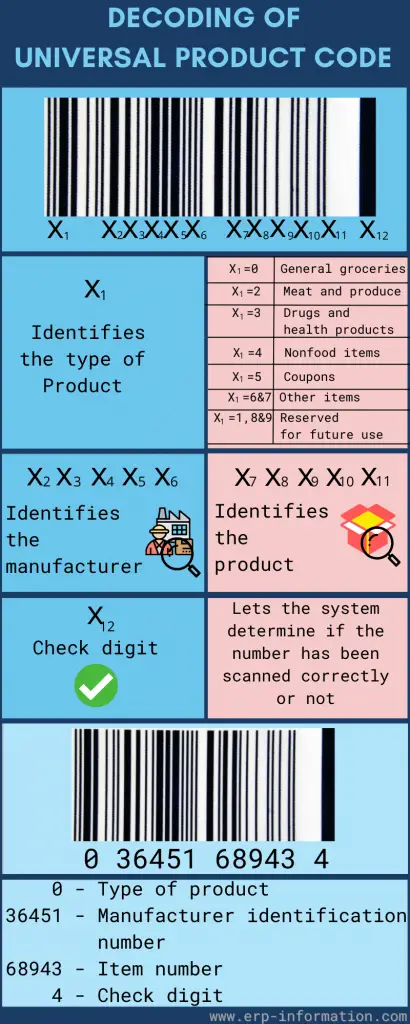
Steps to Get UPC Code for a Product
Application filling The first step is to get the GS1(Global Standard Organization), also known as the Unifor Code Council company prefix. For that, you have to fill out the online application form and sign up for a prefix capacity plan to get it. It shows the number of universal product codes under your company prefix. Paying Fee You have to pay the fee for the code. A prefix capacity plan can be expensive. So make sure that the plan you have chosen will accommodate the long-term use of your business. Once you pay the fee, GS1 allocates a 6-digit number with the manufacturer identification number. This number becomes the first six digits of the universal product code on your company's products. Internal product number generation After getting your company prefix, you can give your product internal product numbers (5 digits). You have the freedom to choose your digits, but each product should have a unique UPC. Ensure that the exact number is not used for more than one product. This 5-digit number represents the product itself. Check digit generation After generating your company prefix and internal product code, generate your check digit. It generates after several calculations by adding and multiplying digits in the code based on an algorithm monitored by the global standard organization(GS1). Manually also, you can calculate the check digit. Confirm check digit is correct or not. If the check digit is incorrect, the UPC code will not scan properly. Registration of final barcode Once all three sets of digits, company prefix, internal product code, and check code are generated, register this number with GS1 so that you will tie your product information to the number you have created. The below infographic provides summarized information on UPC barcode generation steps.
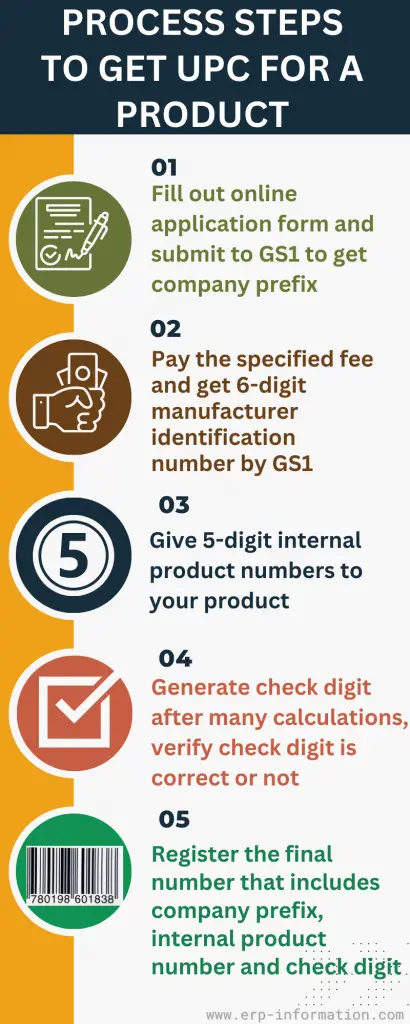
UPC Code's Location
They can be found in most products that you buy in stores. The code is usually located somewhere on the product packaging, and you may also print it on the product. They are also found in product manuals, promotional materials, and shipping boxes.
How to Find a Manufacturer's UPC?
Suppose you want to find the Universal Product Code for a specific product. There are several ways to do so. You can visit the manufacturer's website or contact them directly to ask for the code. You can also use a UPC lookup tool to find the code. These tools are widely available online, and they are free to use. When using a lookup tool, you need the product's name or SKU number. You can usually find the SKU number on the product packaging or manual. Once you have entered the information into the lookup tool, it will return the Universal Product Code for that product. UPC Lookup Tools These tools allow you to search for product codes by keyword or browse by category. They also provide information about the product, such as the manufacturer's name, address, photos, and descriptions. Some tools even let you add products to your inventory. One example is GSOne Global Trade Item Number (GTIN) Database.
Types of UPCs
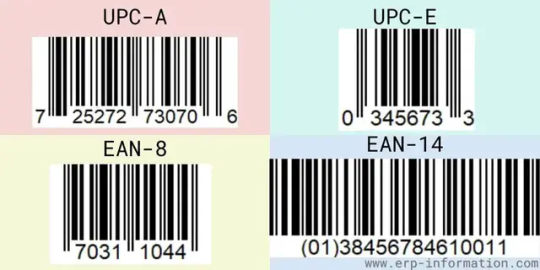
There are a few different types of Universal Product Codes. The most common type is the 12-digit code used to track store products. Codes can also be 6 or 9 digits long. The 6-digit code is used to track products sold in vending machines, and the 9-digit code is used to track online products.
Universal Product Code Generator
A Universal Product Code Generator is a tool that allows you to create Universal Product Codes for your products. This tool is helpful if you want to make your barcodes for tracking purposes or if you want to include them on your product packaging. There are several generators available online. Most of these tools are free to use and easy to use. You need to enter the information about your product, such as the name and SKU number, and the generator will create a valid code for you.
UPC Barcode Specifications
The Universal Product Code Barcode Specifications are guidelines that describe how they should be formatted and used. These specifications are maintained by the Universal Code Council (UCC), a nonprofit organization that oversees the system. The specifications define the following: - The structure and format - The type of information that can be encoded - How it should be scanned and read - They use it in retail environments - They use it in other industries The UPC barcode Specifications are essential for businesses to create or use barcodes. By following the guidelines in these specifications, companies can ensure that their barcodes will be compatible with scanning equipment and that they will be readable in retail stores.
UPC Code Requirements
To create a barcode, you must encode the product's name or SKU number into a barcode format. There are some free online tools that you can use to do this. Once you have created the barcode, you can print it out and attach it to your packaging. Retail scanners scan and read codes, automatically entering the product information into the store's database. This allows businesses to track their inventory and sales without manually entering the information into their database.
Advantages
- They are easy to use and can be scanned by retail scanners. - They speed up the checkout process in stores. - They help businesses track their inventory and sales. - They can be used to create marketing materials such as flyers and product labels. - They are a global standard and are accepted in most countries.
Disadvantages
- Barcodes can be expensive to create and print. - They are not always accepted in all countries. - They can be challenging to create without using a barcode generator tool. - They may not be suitable for all products or businesses. - They require special scanning equipment to read them correctly.
FAQs
How many types of bar codes are there? There are three types of bar codes. They are 1. Universal Product Code (UPC) 2. International Article Number (IAN) 3. International Standard Book Number (ISBN).What is EANEAN stands for European Article Number, also known as International Article Number. It is an international standard for identifying products and services within the EU and elsewhere. In 2009, 13-digit Global Trade Item Number (GTIN) replaced EAN. EAN-13 is the most commonly used 13-digit EAN standard. What are the differences between UPC and EAN?The differences are as follows. EAN is used mainly in Europe, while UPC is primarily used in the United States. EAN codes have 13 digits, while UPCs have only 12 digits. Furthermore, EANs are encoded to contain information about the product's country or region of origin. In contrast, UPCs do not include this information because they are only used in the US and Canada.
Conclusion
In this post, you learned what Universal Product Codes are and how businesses can use them. You also learned about their advantages and disadvantages of them. We hope the article provided quality information. Read the full article
0 notes
Text
What is UPC (Universal Product Code)

the typically found 12 digits as the barcode on almost any products found in the retail world.

Universal product code barcode types realistic set with two-dimensional matrix symbols and numbers system vector illustration The universal product code (UPC) is a 12-digit number and associated machine-readable barcode used to identify products being bought in grocery shops. The first and last digits are separated from the others and written in smaller font size. It consists of two parts, the machine-readable barcode, which is a series of unique black bars, and the unique 12-digit number beneath it. The purpose of UPCs would be to make it straightforward to determine product characteristics, such as the brand name, product, size, and color, when an item is scanned at checkout. That's the reason they have been made in the first place, To accelerate the checkout procedure at grocery shops. UPCs are also valuable in tracking inventory in a store or warehouse. Read the full article
0 notes
Photo

In 1974, a supermarket in Ohio scanned the very first UPC code on a pack of gum to automatically register the item and price. Universal Product Codes FTW! (06/26/18) #timehop #abethedino #clydedawson #sharonbuchanan #marshsupermarket #troy #ohio #wrigleys #juicyfruit #chewinggum #upc #universalproductcode #barcode #symbology #summer1974 (at Toronto, Ontario)
#troy#wrigleys#universalproductcode#symbology#summer1974#sharonbuchanan#chewinggum#barcode#timehop#abethedino#ohio#juicyfruit#marshsupermarket#clydedawson#upc
0 notes
Photo

Zippo COLLECTION 80th Anniversary BARCODE🔥1973 #upc #universalproductcode #pennsylvania #barcode #possystem #zippo #oillighter #madeinusa #bradford #photooftheday #picoftheday #photography #photoglobe #photographs #leica #olympus
#possystem#photoglobe#pennsylvania#photography#photooftheday#upc#leica#universalproductcode#zippo#barcode#madeinusa#picoftheday#olympus#bradford#photographs#oillighter
0 notes
Photo

Universal Product Code
A code labelled on a product package to easily identify what type of product is in the package. This code contains a barcode (machine-readable unique black bars) and a series of numbers used in tracking inventory within a warehouse.
The number is between eight and 12 digits. The first 6 to 10 digits represent - manufacturer's identification number, the next 1 to 5 represent - item number and the final digit represents - check digit, which ensures the accuracy of the code.
Two main parts:
• Machine readable barcode which you may recognize as a set of black bars that is unique to the item it identifies. • The second part is the 12 digit number beneath the barcode.
Plays an integral role:
• A merchant uses a barcode reader to scan this barcode of a product at checkout. • The barcode reader transmits this data to a point-of-sale (POS) system and looks up the number. • The POS computer automatically retrieves information about the product, including its actual price then, enabling the merchant to sell the manufacturer's product at a reasonable price.
Helps to ensure that the correct item has been selected by reducing loss and increasing inventory accuracy.
#fresa #freightsolutions #freightforwarding #universalproductcode #billoflading #vessel #export #freightforwardingsoftware #import
0 notes
Text
Peanut and almond butter recall | washington.allembru.com
0 notes